
I found this example over the internet, where Ron talks about a kindergarten kid who needs to go to his home and he doesn’t know the path. I think I have listed enough here, now let’s get into two very good analogies that I found over the internet and they really helped me to understand the SR operation when TE is configured over SR. Also the best part is the SDN controller based control plane.The prefix sid steers the traffic to the right node and the adj sid steers the traffic to the right adjacency to reach that node.On each router we mention an index value which is carried in the IGP advertisement and the receiving end calculates the label based on index value it has received from the node.It is done on the basis of SRGB (segment routing global block) defined on the router, for example if the SRGB defined on the router is 16000 to 23999 which is also the default SRGB and router receives 5 as index value then the label would be 16005.There are two important components in SR, Prefix-SID and Adjacency SID, with the help of these two we can reach anywhere in the network.As we are using links state routing protocols, we can use IGP FRR in segment routing.Now the intermediate nodes just have to remove(pop) the labels belonging to them and steer the packet to the node where the next label belongs to. In case of MPLS-TE segment routing uses source routing where the source knows about the complete path and while sending packet out it just embeds that path in the packet.



Before getting into the configuration I really wanted to discuss few major points we should know about segment routing and how those are bringing change in the world on layer-2 forwarding.

Now, lets get started with Segment routing. Please check my blog on how to configure GNS3 as a remote server here How to Run GNS3 in Client Server Mode This blog is very close to my heart because this is the first one where the lab is done on my recently built remote GNS3 server.


 0 kommentar(er)
0 kommentar(er)
